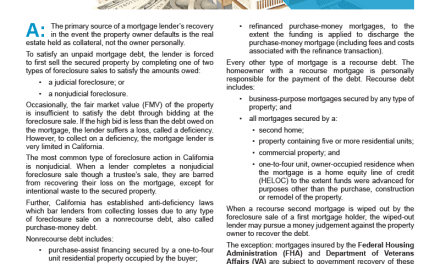Principal reduction (cramdowns) granted by bankruptcy courts is the only solution to underwater homeowners’ plight, a recent article from Daily Finance argued. Unlike recent endeavors to implement cramdowns through bank settlements, cramdowns granted through the bankruptcy courts have historically proven to effectively mitigate widespread negative equity without undue moral hazard.
In the 1980s, farmers in the Midwest faced a post-bubble plight similar to that of today’s California negative equity homeowners. Top-heavy loan-to-value (LTV) ratios resulted in defaults and foreclosures until Congress passed special legislation enabling bankruptcy courts to grant cramdowns to farm owners declaring bankruptcy.
Just as today’s lenders cry out in fear against the moral hazard created by cramdowns, lenders in the 1980s negative equity crisis opposed the emergency measure. While cramdowns were given to many homeowners, most of the damage control was accomplished without resorting to cutting principal amounts on loans. After bankruptcy courts were given authority to cut principal, lenders became suddenly more willing to negotiate mortgage modifications with farm owners than suffer the alternative now at the property owner’s disposal.
Negotiations between lenders and government agencies have not been successful in producing widespread loan modification and cramdowns because lenders have no impetus to follow through on their promises. Thus, the prodding of the Home Affordable Modification Program (HAMP) and the Troubled Asset Relief Program (TARP) of lenders to do workouts are unproductive.
Bankruptcy courts had the authority to cut principal until relatively recently. Congress passed national legislation against cramdowns in 1978, then further banned the practice through the Bankruptcy Abuse Prevention and Consumer Protection Act of 2005. Cramdowns are still permitted for nearly every kind of loan (including loans for investment properties) except those used for the purpose of purchasing a principal residence.
Cramdowns preserve property value by limiting supply in a housing market glutted with vacant properties. The general economy also benefits as people are able to sell their homes for fair market value (FMV) and move to find jobs, thus benefitting the labor market and boosting consumer expenditures as those providers employed have more disposable income.
first tuesday take
Ditto. This recent article echoes one of first tuesday’s staunchest mantras: bring back the cramdown!
Acknowledgement of the merits of cramdowns to mitigate gross damage to the California housing market and the economy as a whole is spreading. Even the Federal Housing Finance Agency (FHFA) has admitted the potential of cramdowns to save taxpayers hundreds of millions of dollars. Yet many continue to oppose the implementation of cramdowns as if it is a terrifying unknown that will produce as yet unforeseeable damage.
Related article:
Reports suggest FHFA killed cramdowns without cause
Cramdowns are not new, and as the history of the 1980s shows us, their institution does not result in cataclysm. Those protesting the injustice of cramdowns for underwater homeowners need to put decision power back into the bankruptcy court’s hands and let judges decide what is fair.
Related articles:
Bankruptcy’s often overlooked tie to homeownership
Bankruptcy: returning the risk to lenders
The moral hazard behind mortgage modification
Re: “Don’t Ask, Just Cram: It’s Time to Put Mortgage Modifications Back into Judges’ Hands” from Daily Finance













